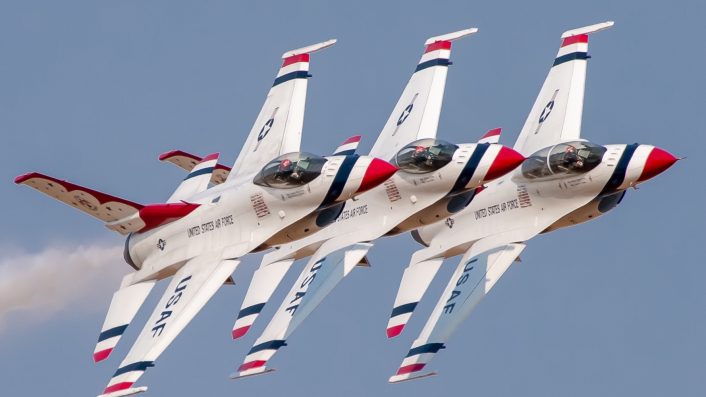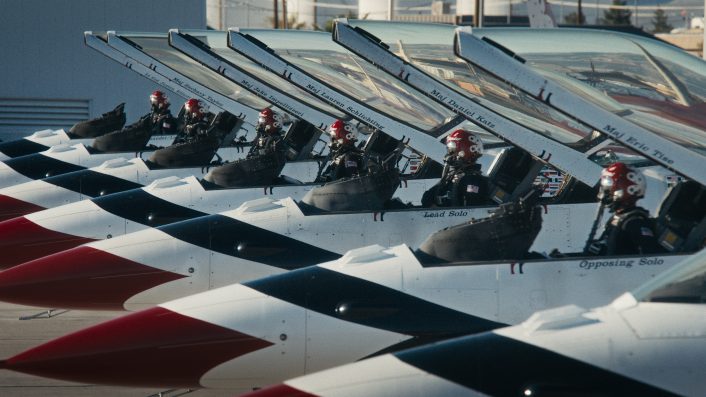Upcoming Netflix Thunderbirds Documentary Could Be Journalistic and Gritty.
You likely remember last year’s “Blue Angels” feature documentary from director Paul Crowder. The film followed the U.S. Navy’s flight demonstration team through off-season team selection and air show preparation. “Blue Angels” opened in movie theaters the weekend of May 17-19, 2024. Released on the heels of massive commercial success for the Hollywood blockbuster, “Top Gun: Maverick”, the “Blue Angels” documentary experienced better than projected box office success just as the 2024 airshow season got underway.
But the warm box office reception for the 2024 “Blue Angels” movie contrasted with critical reviews that panned the film as being too promotional and little more than a heavily scripted “hype piece” for the U.S. Navy flight demonstration team. And while audiences were wowed by spectacular aerial photography and a level of access to the Blue Angels not yet seen in mainstream media, even fans said the film was clearly more of a promotional product than a journalistic one.
Fast forward to the upcoming Netflix documentary, “Air Force Elite: Thunderbirds” to be released on May 23, 2025. In the tradition of Netflix documentary productions on other, similar subjects like Formula 1 racing, “Air Force Elite: Thunderbirds” may be a very different film than the highly scripted, starched flight suit vibe of “Blue Angels”.
If one key difference emerges between the fabricated, hype-heavy feel of “Blue Angels” and the promise of the upcoming Thunderbirds film, it is Netflix itself. Netflix has had resounding success with less scripted, more revealing sports and event documentaries like the blockbuster 2019 docu-drama, “Formula 1: Drive to Survive”.
For the first time ever, “Drive to Survive” featured behind the scenes, profane tirades by billionaire racing moguls and toy-throwing tantrums by spoiled-brat F1 race car drivers. The groundbreaking documentary series, which is one of Netflix’s most successful and continues in production today, was partially credited with Formula 1’s massive surge in commercial growth since 2019.
Authors Joshua Robinson and Jonathan Clegg even suggested in their 2024 book, “The Formula” that, had it not been for Netflix and their unflinching tell-all about Formula 1 racing, the sport may have faltered altogether. This observation may be even more relevant now under the new U.S. administration and the emergence of widespread federal cost-cutting programs from the newly formed Department of Government Efficiency or “DOGE” headed by Elon Musk. Musk has been highly critical of U.S. Department of Defense fiscal policy, having tweeted on his media platform “X” that the F-35 Joint Strike Fighter program was a, “waste of money” and the “worst military value for money in history”.
And while flight demonstration teams like the Thunderbirds and Blue Angels have proven their financial return in measureable recruiting and promotional statistics, they also seem like a conspicuous target for being bitten by the DOGE.

But a different editorial perspective in “Air Force Elite: Thunderbirds”, if it emerges when the film is released on May 23, 2025, could reinforce the vital role the U.S. Air Force’s flight demonstration team plays in recruiting and provide a less scripted, more human view of the Air Force’s newest generation of Thunderbird team members. It may even cause a continuing resurgence in relatively poor Air Force recruiting numbers during the last decade. And if this new Netflix documentary does for Air Force recruiting what “Drive to Survive” did for Formula 1 popularity, the Air Force better start building new training facilities.
Another potential difference between the 2024 “Blue Angels” and the upcoming “Air Force Elite: Thunderbirds” is how the films are being distributed to audiences. “Blue Angels was a general release made-for-theaters film distributed by media conglomerate Amazon MGM Studios. And while there has been little published about this, the film left viewers and critics with the sense that the U.S. Navy may have retained significant editorial control over how their flight demonstration team was depicted. “Air Force Elite: Thunderbirds” is a made-for-Netflix production. Because of this, we may expect a very different editorial perspective. So far, the comments by production staff on “Air Force Elite: Thunderbirds” seem promising.
Producer Matt Wilcox said, “If we could really showcase the trials and tribulations and the grit and the risk of what it takes to do this — and more importantly why they do it — we could unpack a more powerful story.” These comments suggest a more journalistic look and voice to “Air Force Elite: Thunderbirds”.
If the newly released teaser-trailer for “Air Force Elite: Thunderbirds” is any indication of the editorial direction the film is taking, then the promise of a more transparent view of the risks and trials of flight demonstration will be an important theme in the documentary.
The two-minute, forty-seven second trailer released via YouTube on April 29, 2025 opens with a sound bite from a Thunderbird pilot telling the production team, “You are microseconds of lag from a life-threatening situation”. The trailer goes on to give a peek at an interview with USAF Major Eric “Miami” Tise, then-Thunderbird #5, Lead Solo, telling the camera, “We’re always a little bit under the, I’m gonna die factor”.
But however the soon-to-be released April 29 Netflix documentary plays out, whether another highly-scripted hype piece for aviation geeks or a more mainstream documentary look inside the Thunderbirds, “Air Force Elite: Thunderbirds” is likely to be a much needed update to the only previous Thunderbird documentary, an obscure cable TV production from 2001 called, “Reach for the Sky”.
The 2001 film never reached widespread media distribution since it was released four years before YouTube went live and six years before Netflix began its streaming service. This vintage Thunderbird film was originally a Public Broadcasting System (PBS) release that did eventually go to DVD sales, and now languishes in the archives of YouTube with only 1,300 views over eleven years. So, the U.S. Air Force Thunderbirds are long overdue for a mainstream media update.










